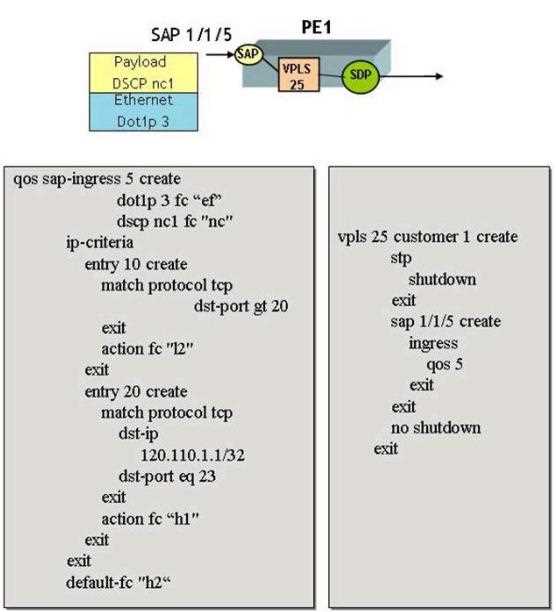nokia 4a0-107 practice test
Nokia Quality of Service
Question 1
The IP ToS field consists of ________ bits, of which ________are used. The _________most
significant (first) bits define precedence.
- A. 8, 6, 3
- B. 8, 8, 6
- C. 16, 8, 4
- D. 8, 6, 4
- E. 24, 16, 8
Answer:
A
Question 2
Which of the following are examples of metrics for QoS?
- A. Signal degradation, attenuation, line loss
- B. Latency, FIFO, WRED
- C. Delay, jitter, packet loss
- D. SNR, queue depth, latency
- E. Attenuation, dispersion, latency
Answer:
C
Question 3
What is the 6-bit binary representation of DSCP value AF21?
- A. 010011
- B. 100010
- C. 010001
- D. 001100
- E. 010010
Answer:
E
Question 4
Which of the following statements regarding DSCP bits are TRUE? (Choose three)
- A. The three most significant (first) bits define 8 forwarding classes.
- B. The three least significant (last) bits of the DSCP specify the drop probability.
- C. The full 8 bits of the TOS field are used for DSCP.
- D. To convert DSCP to IP precedence, the three most significant (first) bits are matched.
- E. DSCP provides for eight drop probabilities.
Answer:
A,B,D
Question 5
Which of the following can be used as classifiers of customer traffic? (Choose three)
- A. DSCP value
- B. 802.1p value
- C. IP DF bit
- D. TCP/UDP port numbers
- E. HTML version number
Answer:
A,B,D
Question 6
Which of the following are characteristics of DSCP? (Choose two)
- A. DSCP is part of the Layer 3 header.
- B. DSCP is a 6-bit field.
- C. DSCP specifies eight different priorities.
- D. DSCP specifies four precedence levels.
- E. DSCP is part of the Layer 2 header
- F. DSCP specifies 128 different per-hop behaviors.
Answer:
A,B
Question 7
What is an SLA? (Choose two)
- A. An SLA is used to provide automated, real-time testing and alarming for throughput, latency, and jitter across a provider's network.
- B. An SLA is an agreement between a customer and a provider that dictates the treatment of customer traffic across the provider's network.
- C. An SLA allows customers to control all traffic within the service provider's network by prioritizing their traffic over others as desired.
- D. An SLA allows a customer to pre-mark traffic and ensure that traffic is treated as per the agreement within the provider's network.
- E. An SLA is a standard set of network QoS policies that a provider shares to all its customers, allowing them to better understand the treatment of traffic within the provider's network.
Answer:
B,D
Question 8
How many bits does DSCP use to provide QoS marking options?
- A. 8
- B. 16
- C. 6
- D. 4
- E. 3
Answer:
C
Question 9
Which of the following are major components of QoS functionality on the Nokia 7750 SR? (Choose
three)
- A. Microflow reservations using RSVP
- B. DSCP to EXP translation
- C. Traffic classification
- D. Automatic profiling and policy configuration
- E. Buffer memory management
- F. Traffic scheduling
Answer:
C,E,F
Question 10
Which of the following are characteristics of 802.1p? (Choose two)
- A. 802.1p adds 16 bits to the Layer 2 header,
- B. 802.1p adds 16 bits to the Layer 3 header.
- C. 802.1p specifies 64 different priority levels.
- D. 802.1p uses a field in the 802.1Q header.
- E. 802.1p uses a field in the Layer 3 IP header
- F. 802.1p defines a 3-bit Class of Service field.
Answer:
D,F
Question 11
Which of the following BEST describes a SAP when regarding QoS?
- A. A point in the network where EXP bits can be mapped to one of eight predefined FCs, each one with its own queue.
- B. A logical point in a service tunnel where all of customer traffic is aggregated.
- C. A point at which the initial classification of customer traffic occurs.
- D. A point in the network where QoS parameters are discarded in favor of lower-level hardware queuing functions, such as LLI (Link Layer Interleave).
- E. A point in the network where traffic flows from multiple different services are queued together, based on forwarding class.
Answer:
C
Question 12
Individual application streams are considered microflows, whereas __________ are considered
macroflows.
- A. SAPs
- B. SDPs
- C. Services
- D. Queues
- E. Schedulers
- F. Forwarding classes
Answer:
F
Question 13
What is the maximum number of SAP-ingress policies that can be applied on a SAP?
- A. 1
- B. 2
- C. 3
- D. 4
- E. 5
- F. 8
Answer:
A
Question 14
Click the exhibit button below.
Based on the configuration shown below, name the forwarding class to be associated with a TCP
packet encapsulated inside an Ethernet frame that arrives on SAP 1/1/5 with the following
characteristics:
Destination IP address = 120.110.1.1
TCP port number = 23
DSCP value = nc1
Dot1pvalue = 3
- A. H2
- B. NC
- C. L2
- D. EF
- E. H1
- F. BE
Answer:
C
Question 15
Which of the following are possible criteria for classifying packets at the network port ingress on the
Nokia 7750 SR? (Choose three)
- A. The EXP bits in the MPLS header.
- B. The packet's source and destination IP addresses.
- C. The packet's DSCP bits.
- D. The dot1p bits in the frame header.
- E. The ID of an SDP that is transporting the packet.
Answer:
A,C,D